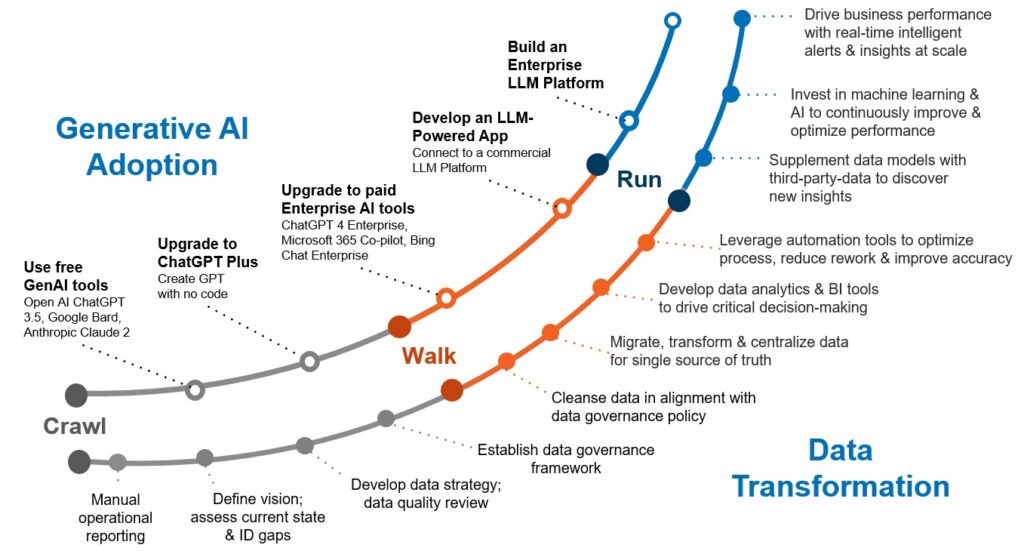As generative artificial intelligence (GenAI) becomes more accessible and expansive, business leaders need a plan to harness its potential while mitigating risks. This requires strategic planning activities, including exploring use cases, drafting an implementation roadmap, creating ethical usage policies, and elevating organization-wide AI literacy.
There are two parallel paths organizations must take to successfully encourage the safe implementation of AI while proactively mitigating risks:
- Build a strong data-driven foundation.
- Experiment with GenAI to create momentum for adoption.

Current AI trailblazers and innovators are already on this course. It’s beyond time for other organizations to follow suit.
1. Build a Data-Centered Mindset
A data-centered mindset is the precursor of a successful data transformation journey. This consists of having:
- A data strategy.
- Necessary governance mechanisms.
- The required initial infrastructure (people, processes, and technology).
- A capable team.
- Organizational data literacy.
Together, these components enable companies to innovate and embrace GenAI safely and responsibly.
To build a strong data foundation, companies should specifically consider the following actions:
Establish Data Strategy and Governance
An effective data strategy should drive the decision-making process of technology selection, including GenAI technology, as well as the assessment of use cases. Of course, these decisions should align with business needs, pain points, and goals.
Leaders must ask “What tasks or functions could AI assist with?” “How could it improve operations or services?”
Understanding the problems to be solved will help guide implementation and the selection of technology.
Clear data governance allows the company to translate the strategy into an actionable roadmap. This includes:
- Defining data roles.
- Distributing responsibilities between stakeholders.
- Setting GenAI usage guardrails.
- Establishing measurable objectives at all levels of the company.
Additionally, having a clear understanding of the organization’s risk landscape and how the usage of GenAI fits into it will enhance the organization’s ability to respond to new opportunities and risks and the ability to identify key gaps along the way.
Focus on Data Centralization and Tool Selection
With an explosion of technological advancements, companies must control where their data is created, transformed, and stored. It’s estimated the average enterprise uses more than 470 SaaS applications – SMBs rely on roughly 250 as well.
As the data technology space becomes more complex, so does the ability to manage and track multiple data sources. Selecting GenAI tools to kick-start experimentation doesn’t need to be a colossal task.
Develop a short list of current market offerings and their capabilities to efficiently select a Large Language Model (LLM) that employees can start leveraging for everyday tasks. In parallel with this initial experimentation tool, develop a longer-term plan for enterprise-level tools, carefully considering infrastructure needs, including hardware, software, and connectivity required to develop, host, and integrate broader GenAI into your data ecosystem.
Team Building and Increasing Data Literacy
While experimentation can be done with a handful of early adopters within the business, organization-wide adoption requires a data-literate workforce. Gartner’s Annual Chief Data Officer survey indicates that less than a third (29%) of companies are successfully meeting ROI objectives from the rollout of their data and analytics initiatives. Developing a literacy program with curated training materials and capable instructors is key to a successful implementation.
2. Promote GenAI Experimentation
There are several ways to shepherd GenAI adoption within the business, and, often, certain employees or departments will be ahead of the curve while others may be more averse to experimenting with new tools. To encourage responsible experimentation in a way that isn’t too aggressive, intimidating, or disruptive to normal operations, focus on the areas below:
Start With Everyday Tasks
OpenAI’s ChatGPT 3.5, Google’s Bard, and Anthropic’s Claude 2 are a few existing examples of public LLMs that can be accessed for free by all users. Similar to many other data-driven or business intelligence tools, the best way to grasp and understand the capabilities of the LLM is to use it.
Featured Insight
While the free versions of these LLMs do not offer protection of your proprietary business data, employees can still make great use of these tools in ways that don’t involve confidential data.
Some employees may leverage the LLM as a teacher for existing marketplace technologies, while others may use it as an accelerated and more efficient research assistant. The teacher can walk through the steps of building the first workflow in an automation tool, while the research assistant can synthesize an industry article from a 10-minute read into a 1-minute read. As employees prompt the LLM for these low-risk use cases, each employee’s AI literacy increases.
GenAI literacy is imperative to estimate ROI for projects and implementations in this space. Enterprise executives list “unproven ROI” as a key barrier to GenAI adoption. The experimentation phase helps to refine exactly how LLMs can slot into workflows, which can lead to more informed and data-driven assumptions around the true ROI that can be expected.
Leverage Existing Tools
Within the last year an increasing number of technologies, especially those focused within the business intelligence and data analytics industry (e.g. Alteryx, Tableau, PowerBI, Qlik Sense, Snowflake), have seamlessly integrated GenAI capabilities into their offerings.
Some of these tools may offer an API that allows users to interact with an LLM from within the existing technology’s user interface, while others have fully integrated GenAI capabilities into their technology, allowing the auto-completion of code written by the user or the auto-generation of new insights from data. Technology leaders should speak with their third-party technology partners about safely experimenting with GenAI within the bounds of their existing offerings.
Explore expert Data Transformation & Analytics solutions that solve real-world problems
Accelerate strategic adoption of data, analytics, and artificial intelligence platforms within a scalable systems architecture for efficient reporting, cleaner insights, and greater change readiness.
Crowdsource Use Cases
Due to both the novelty of LLM capabilities and the breadth of their use cases, it can be difficult to build a use case list until the organization develops an initial familiarity with the technology. The initial focus on leveraging the LLM in everyday tasks is nearly guaranteed to spur new, more intricate use case ideas by those experimenting. There should be a central repository for the organization’s use case ideas that individuals can add to in real-time as they work and ideate with the LLM.
The Right GenAI Partner
CrossCountry Consulting can build out this initial use case list specific to your business and your industry and provide priorities so your organization maintains its momentum without becoming overburdened by the exponential proliferation of use cases. Proving the effectiveness of the first few use cases is a significant stride toward a culture that values the transformational capabilities of GenAI.
Our Data Transformation & Analytics team believes that a successful GenAI journey starts with a strong data strategy and is accelerated by safe experimentation. It’s critical to get the correct foundations in place, whether that’s refining your data strategy and governance model, selecting the initial LLM to experiment with, exploring your existing tools for add-on GenAI capabilities, or developing and prioritizing your use case list.
Contact CrossCountry Consulting to get started.

